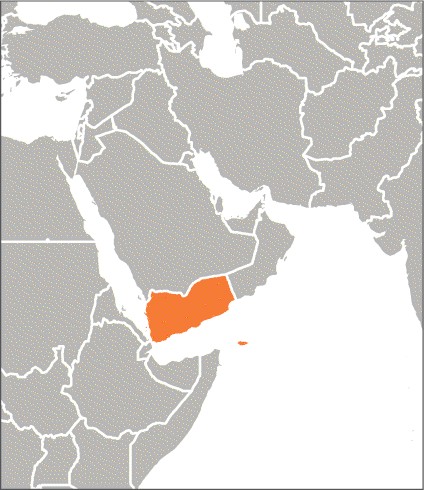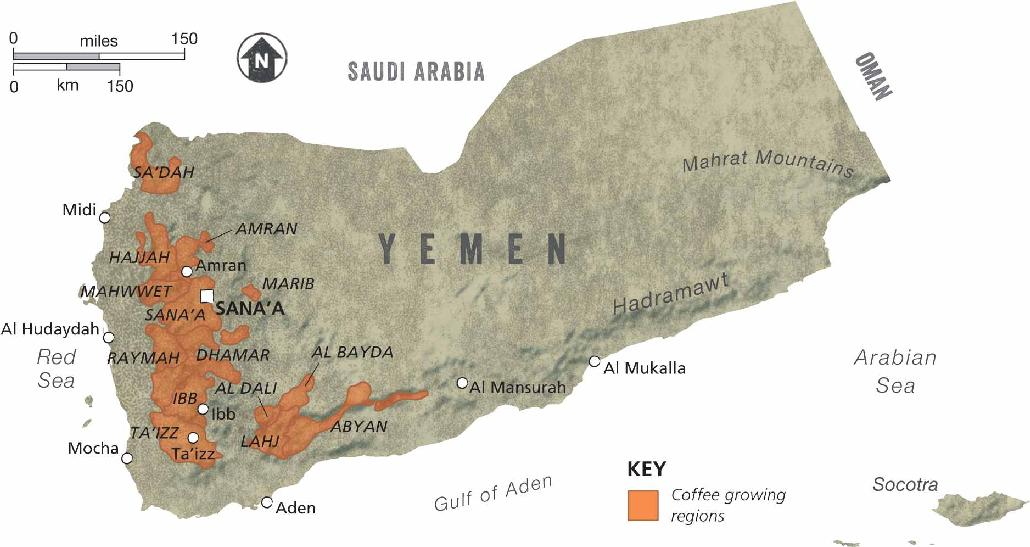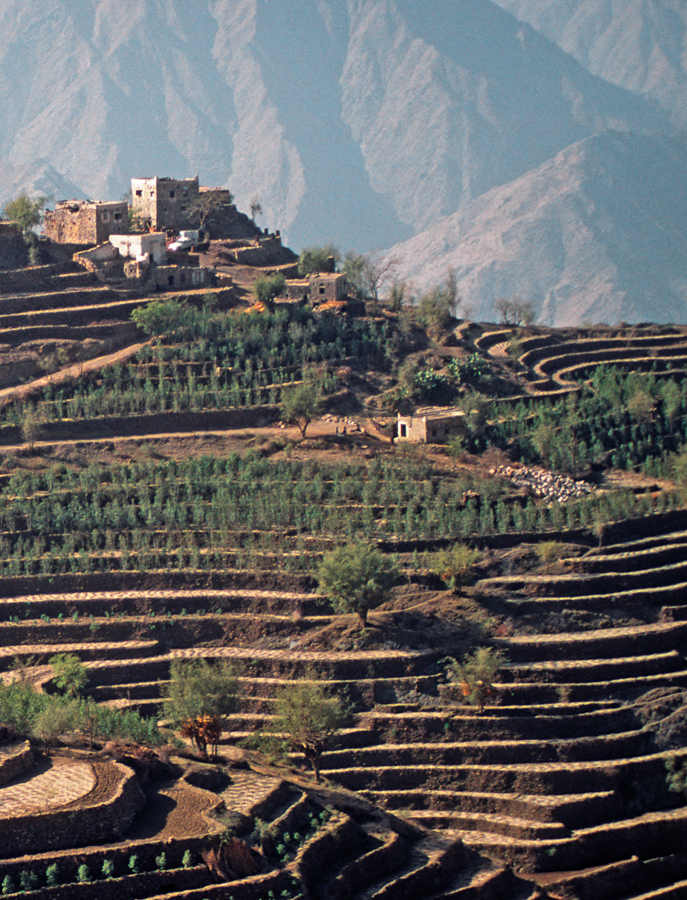Yemen has been producing coffee on a commercial basis for longer than any other country, and its coffee is distinctive, perhaps challenging, and certainly unusual. Despite a strong demand for Yemeni coffee over the centuries, its trade has never commoditized. Yemen is unique, from its coffee varieties and its terraced farming to its processing and its trade.

Coffee came to Yemen from Ethiopia, either through trade or those making pilgrimages from Ethiopia to Mecca, and was well established in the country in the 15th and 16th centuries. Export of its coffee introduced the world to the port of Mocha, and I think it is fair to say that ‘mocha’ is probably the most confusing word in all of coffee’s lexicon (see The Term ‘Mocha’).
Only three per cent of the land in Yemen is suitable for farming, water being the major limiting factor. Coffee is grown on terraced land at high altitudes and additional irrigation is required to keep the coffee trees healthy. Many farmers depend on non-renewable sources of deep underground water, and there is some concern over depleting stocks. Fertilization of the soil is not particularly common, so there is an additional problem of depleting soil nutrients. All these factors, coupled with the sheer remoteness of the coffee-growing regions, go some way to explaining the huge number and variation of heirloom varieties of Arabica found in the country, most of them peculiar to their growing regions.
Yemen’s coffee is picked by hand, with pickers visiting a tree several times in a season. Despite this, selective picking is not particularly commonplace, with underripe and overripe cherries often being harvested. Whole cherries are usually dried in the sun after harvesting, often on the roofs of the farmers’ homes. Rarely do these roofs provide enough space, so the cherries are often piled too deep to dry correctly, resulting in defects such as uneven drying, fermentation and mould.

Each producer may only grow a very small amount of coffee. Data from the 2000 census shows that around 99,000 households produced coffee, and based on estimates of production the average household produced just 113kg (249lb) of raw coffee that year.
There remains a strong global demand for Yemeni coffee, and about half of exports go to Saudi Arabia. Coupled with limited production and relatively high production costs, this makes it sell for high prices. Demand has not increased the traceability of the coffee, and it can travel through a network of middlemen from the farmer through to the exporter. Coffees can also sit for quite some time (often years) at the point of export, as some exporters sell their oldest stocks first, and warehouse their newer crops in caverns underground.
Since the civil war began in 2015, coffee production in Yemen has been badly affected. The actual volumes produced have decreased only a little, but exports have fallen to a little over half of what they were before the war. Be aware that there has been an increase in the fraudulent mislabelling of Ethiopian coffees, with many being presented as Yemeni coffees to try to meet the existing demand and achieve a premium price.
THE TERM ‘MOCHA’
Originally, the word referred to the port in Yemen from where coffee was exported. This spelling soon changed to ‘moka’, and the term was used to describe the potent and pungent coffees produced in Yemen. Some naturally processed coffees from other countries are still described this way, such as Moka Harrar from Ethiopia.
The coffees from Yemen were often blended with coffees from Java, and the Mocha-Java blend was born. However, the name was not protected and thus became a kind of stylistic term used by many roasters to describe the flavour of a particular blend they created, rather than where the component coffees came from. The current use of the term ‘mocha’ to describe a mixture of hot chocolate and espresso only serves to further bewilder the consumer.
QESHER
Qesher, also Q’shr or Qishr, is a by-product of coffee production. It is the dried, but not roasted, husks removed from the coffee cherries. In Yemen, these husks are often brewed like tea as a way to consume a form of coffee. More recently, producers in Central America have been experimenting with the same product, there called cascara. This is usually just the dried fruit of the cherry, rather than both the fruit and the dried parchment seen in qesher.
TRACEABILITY
Trying to understand exactly where coffees come from in Yemen can be extremely confusing. Often the name of the coffee will include the term ‘Mocha’, indicating the port from which it was exported. Usually coffees are only traceable back to a particular region within Yemen, rather than to the farm where they were produced. It is also common to see the local names for different coffee varieties used to describe the coffee, such as Mattari.
 In the old city of Al-Masnaah, northwest of Sana’a, a vendor makes coffee for his customers. The Yemeni coffee trade is several hundred years old and harvests continue to be highly sought after.
In the old city of Al-Masnaah, northwest of Sana’a, a vendor makes coffee for his customers. The Yemeni coffee trade is several hundred years old and harvests continue to be highly sought after.

Only three per cent of Yemen is suitable for agriculture owing to the scarcity of water. This terraced plantation in a traditional small fortress town is typical of Yemeni coffee farming methods.
Having better levels of traceability doesn’t necessarily guarantee better quality. Often different coffees are blended together before export, and exported under the most valuable name. The high demand for Yemeni coffee is based on its unusual, wild and pungent flavours – and these come in part from defects in the process. If you want to try coffee from Yemen, it is advisable to source one from a supplier with whom you have already built some level of trust. Roasters will need to cup through many terrible samples to find a good one. Buying blindly as a consumer stacks the odds against you and you may end up with something that tastes dirty, rotten and unpleasant.
TASTE PROFILE
Wild, complex and pungent, a completely distinctive coffee experience, different from other coffees around the world. For some the wild, slightly fermented fruit quality is off-putting, while others prize it highly.
GROWING REGIONS
Population: 25,408,000
Number of 60kg (132lb) bags in 2016: 125,000
Please note that westernized spellings of place names in Yemen can vary quite dramatically. Each region described in Yemen is a governorate, rather than a geographically defined region. Yemen has 21 governorates, but only 12 grow coffee and even fewer are key producers.
SANA’A
Many of the premium coffees exported from Yemen bear the names of the varieties grown in this region. Confusingly, Mattari can be used to describe a region (around Bani Matar), and the name of the variety is probably derived this way. The region is based around the city of Sana’a, one of the oldest continuously populated cities on earth, and at 2,200m (7,200ft) above sea level, also one of the highest. As a region, this is the largest producer of coffee in the country.
| Altitude: | 1,500–2,200m (4,900–7,200ft) |
| Harvest: | October–December |
| Varieties: | Heirloom varieties such as Mattari, Ismaili, Harazi, Dawairi, Dawarani, Sanani, Haimi |
RAYMAH
This small governorate was established in 2004. It produces a reasonable amount of the country’s coffee and has increasingly been the focus of water-management projects by non-government organizations to help increase coffee yields in the area.
| Harvest: | October–December |
| Altitude: | average of 1,850m (6,050ft) |
| Varieties: | Heirloom varieties such as Raymi, Dwairi, Bura’ae, Kubari, Tufahi, Udaini |
MAHWEET
Located south of Sana’a, the city of At-Tawila rose to prominence between the 15th and 18th centuries as a hub for coffee-growing in the region. The city was a collection centre for coffee before it headed to ports for export.
| Altitude: | 1,500–2,100m (4,900–6,900ft) |
| Harvest: | October–December |
| Varieties: | Heirloom varieties such as Mahwaiti, Tufahi, Udaini, Kholani |
SA’DAH
This governorate has unfortunately been plagued by civil war since 2004. Confusingly sada is an Arabic term for black coffee, and is popular throughout the Middle East, often served with the addition of spices.
| Altitude: | average of 1,800m (5,900ft) |
| Harvest: | October–December |
| Varieties: | Heirloom varieties such as Dawairi, Tufahi, Udaini, Kholani |
HAJJAH
This is another small producing region, centred around the capital city of Hajjah.
| Altitude: | 1,600–1,800m (5,200–5,900ft) |
| Harvest: | October–December |
| Varieties: | Heirloom varieties such as Shani, Safi, Masrahi, Shami, Bazi, Mathani, Jua’ari |